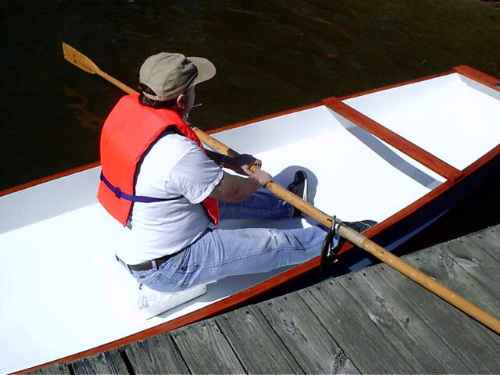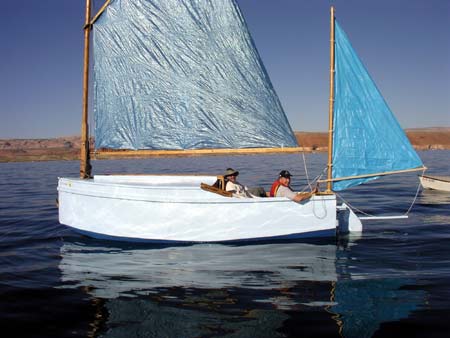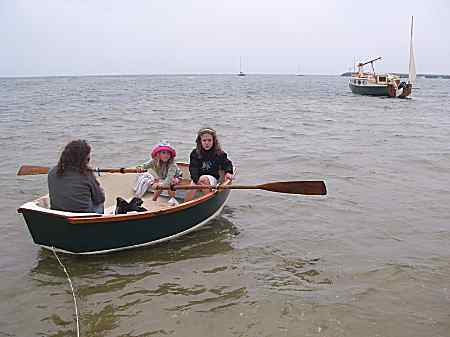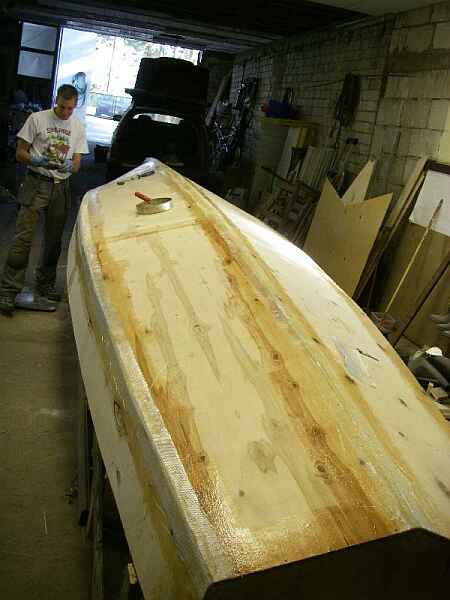
Caroline herself whittles out a spar for her new boat Caroline.
Contents:
Contact info:
Jim Michalak
118 E Randall,
Lebanon, IL 62254Send $1 for info on 20 boats.
Jim Michalak's Boat Designs
118 E Randall, Lebanon, IL 62254
A page of boat designs and essays.
(1jul08)This issue will rerun the rowboat setup essay. The 15 July issue will complete the AF4 rebottoming essays.
WELCOME TO ...
If you got this far I hope you will bookmark it and hopefully it will be permanent. There is lots of room to grow here. It may take a while for me to upload the old issues but you should be able to dig them out of the old earthlinks sight and maybe the even older apci sight and finally there are the old reliable archives at duckworksmagazine.com. I will keep my email at jimmichalak@earthlink.net for now.
THE BOOK IS OUT!
BOATBUILDING FOR BEGINNERS (AND BEYOND)
is out now, written by me and edited by Garth Battista of Breakaway Books. You might find it at your bookstore. If not check it out at the....ON LINE CATALOG OF MY PLANS...
...which can now be found at Duckworks Magazine. You order with a shopping cart set up and pay with credit cards or by Paypal. Then Duckworks sends me an email about the order and then I send the plans right from me to you.

|
Left:
Caroline herself whittles out a spar for her new boat Caroline.
|
|
|
ROWBOAT SETUP
I've been showing photos of Max Wawzyniak's Oracle prototype for the past few month. The project was done a while back but we were frozen in until about the first week of March. Then it all burst out then and we had a day in the 70'sF and it was time to launch. That particular day the wind was gusting to 30 and no testing was going to get done but it was a good day to take photos and also to set the boat up in the way I like to see it done.
We went to Washington County lake here in Illinois which is about a mile long and with many arms, steep hills around and a shallow launch ramp in a protected area. A very nice rowing lake.

The first thing I must say to those who are finishing a new rowing boat is to not install the rowlocks in the shop! I usually show a rowlock location on the drawing but that is just my best guess at the time I drew the boat. If you have a little patience you can get it just right the first time by following this essay.
Max unloaded his new Oracle and showed me his gear. He had made a low rowing seat, 3-1/2" high, and had some nice 8' oars. The seat looks low but you will usually have a cushion on top and this is a low sided boat. This seat turned out to be just right for Oracle.

Next the boat was placed in the water tied loosely to the dock. Max climbed in and we looked for the seating position that would provided a level boat.
Here he is too far forward and you can see that the bow is down and the stern is up. I might add that it really takes two people to get this just right - one to be the skipper, and another to watch for the correct trim since seeing the trim from inside the boat can be difficult.

Here he is too far aft. The bow is up and the stern is down:

Here he is with his weight located properly for a level boat. At this time he marked the seat location on the bottom of the boat so he could easily repeat the location in the future.

Sitting in the properly trimmed boat Max holds the oars comfortably and notes where they cross the wale.

At those points he places a large C clamp in position to simulate the rowlocks.

Now for a test row using those C clamps as thole pins. If the clamps are large enough you might pass the oar through the opening or you might tie the oars to the clamps. In this case Max was just careful to keep the oars against the clamps.

At this point you can shift things around. Once you find the best place for the oarlocks, note the position and install the lock sockets. In this case Max used common sockets mounted outside the wale. He screwed them into position for now, to replace the screws with small bolts in the future. (Screws have a bad habit of working loose at the worst time.) Sockets mounted outside the wale instead of inside? They function a lot better outside with no chafing on the wale but if you are using the boat as a tender then inside the wale might be better because there will be no metal to gouge the mothership.

Not quite done yet. A good rowing setup will also have cleats inside the hull against which you can brace your feet. It's not a big deal in calm conditions but for rowing hard, and in some conditions all rowing will be hard, the cleats will make a huge difference in the amount of force you can deliver to the oar.
Max didn't install his on his test day but the cleats can be about 3/4" square and 6" long and mounted in a comfortable position. Many rowing boats will have several cleats spaced maybe 3" apart to allow for different sizes of oarsmen. Here is a photo of the cleat in my old Roar2. It was meant to be a temporary fit and was plopped in place with a blob of Bondo. Still temporary after 12 years!

Perhaps just as good as a cleat is the arrangement that Rob Rohde-Szudy made for his Piccup Pram with a rope loop to the seat that captures a bracing bar that rests on the floor of the boat:

NEXT TIME: We'll look at the effect of sweeping up a stern on a jonboat hull.
Mikesboat
MIKESBOAT, SAILBOAT, 17' X 5.5', 450 POUNDS EMPTY

Mikesboat is a big Piccup Pram. It is slightly narrower in proportion. The idea was to have something like Piccup that was large enough to take the family so she has two bench seats 8' long. It should be a good expedition solo boat with a boom tent fitted over the cockpit. Mikesboat has the Piccup layout with buoyancy/storage chambers fore and aft but now there is also enough room for a small motor well across the stern. As a rule something like this needs maybe 2hp to run at hull speed and even then there would be some extra. This shape of hull with multichines has proven good in rough water with fair speed.
Sail rig is the same 96 square foot sharpie sprit rig that I used on AF3 and a few other designs (actually it is the mainsail from a Bolger Jinni design I built 20 years ago). This is a change from the balanced lug rig that Piccup uses but Mike had good experiences with his Mayfly12 which used the sharpie rig and that is what he wanted. I would expect the sharpie sprit to be slightly better to windward than the lug but not by a lot and the sailmaker's talents might be the deciding factor here. There is no doubt that the sharpie sprit mast is perhaps 50% longer than a similar lug sail might need.

Mikesboat uses taped seam construction. Takes nine sheets of 3/8" plywood and three sheets of 1/2", compared to Piccup's fives sheets o 1/4". So you see that scaling up a boat makes for a lot more wood and weight.
I dunno if Mike ever built his boat but Bill Moffitt in Atlanta made one to run the Texas200. He is an experienced builder and sailor and made a thorough job of it in a big rush towards the end. Launching at the Texas200 was its first time in the water. His wife sewed the sails the day before he left for the cruise, and this was her first set of sails! The sail rig he wanted was a lug main with a sharpie mizzen. I drew those up for him and they are now included in the plan set. Here is his boat under sail:

Here is another photo of the boat beached beside Chuck Leinweber's mothership Caprice (which was designed originally for Bill Moffitt!) at the end of the cruise:

The cruise involved camping through several nights and Bill did something I have always thought about but had never seen. He pitched a standard tent in the large Mikesboat cockpit. A lot cheaper than a custom boat tent, for sure, but it takes a big cockpit to handle it. Mike also had some sort of center platform to fill the space between the long bench seats:

Well, three cheers for Bill and son Paul!!! As far as I know the 200 mile cruise went off without a hitch, the boat right on. But I suggest that most of us couldn't get away with going on a long cruise with an untested design.
Plans for Mikesboat, showing both sailrigs, are $45.
Prototype News
Some of you may know that in addition to the one buck catalog which now contains 20 "done" boats, I offer another catalog of 20 unbuilt prototypes. The buck catalog has on its last page a list and brief description of the boats currently in the Catalog of Prototypes. That catalog also contains some articles that I wrote for Messing About In Boats and Boatbuilder magazines. The Catalog of Prototypes costs $3. The both together amount to 50 pages for $4, an offer you may have seen in Woodenboat ads. Payment must be in US funds. The banks here won't accept anything else. (I've got a little stash of foreign currency that I can admire but not spend.) I'm way too small for credit cards.
I think David Hahn's Out West Picara is the winner of the Picara race. Shown here on its first sail except there was no wind. Hopefully more later. (Not sure if a polytarp sail is suitable for a boat this heavy.

Here is a Musicbox2 I heard about through the grapevine.

This is Ted Arkey's Jukebox2 down in Sydney. Shown with the "ketchooner" rig, featuring his own polytarp sails, that is shown on the plans. Should have a sailing report soon.

And the Vole in New York is Garth Batista's of www.breakawaybooks.com, printer of my book and Max's book and many other fine sports books. Boat is done, shown here off Cape Cod with mothership Cormorant in background, Garth's girls are one year older. Beautiful job! I think Garth is using a small lug rig for sail, not the sharpie sprit sail shown on the plans, so I will continue to carry the design as a prototype boat.

And the Leinweber's make another prototype! This one by Sandra, an Imresboat shown here on its first outing. They are taking it on a "cruise" so more about it later.

And a new Down Under Blobster, now upside down....

And up in Maine friends gather to turn the Caroline hull:

I gotta tell you that on the Caroline bilge panels I made an error in layout and they are about 1" too narrow in places on the prototype plans. I have them corrected but it always pays, even with a proven design, to cut those oversized and check for fit before final cutting.
And in far off Estonia a Raider takes shape:

And in far off California a Wooboto goes on a five day cruise:

AN INDEX OF PAST ISSUES
Hullforms Download (archived copy)
Plyboats Demo Download (archived copy)
Brokeboats (archived copy)
Brian builds Roar2 (archived copy)
Herb builds AF3 (archived copy)
Herb builds RB42 (archived copy)